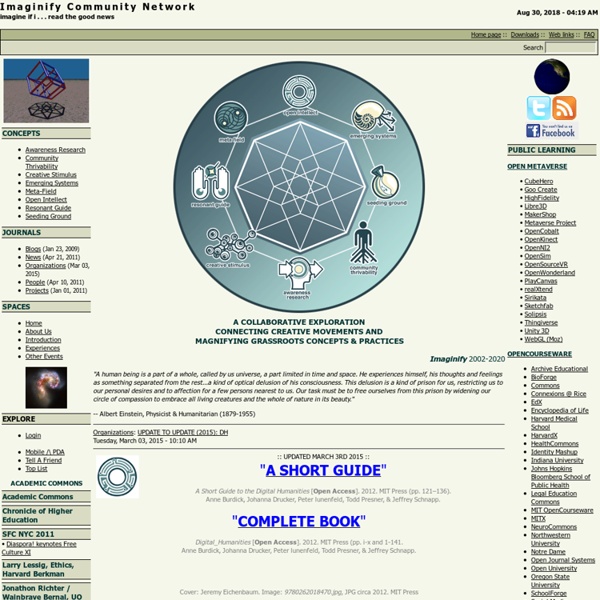Une science de l’intelligence collective ?
L’intelligence collective peut-elle constituer un projet scientifique et si oui lequel. C’est l’entreprise qui occupe Pierre Lévy depuis plusieurs années. Son dernier article mérite donc un examen particulier au-delà des clichés dont il est souvent victime. Il est vrai que certains ouvrages présentaient des prospectives discutables, notamment le world philosophy qui représentait surtout à mon goût une vision trop positive de l’avenir, oubliant justement les éléments malveillants (ce que remarquait fort justement Yann Leroux sur twitter). Voici donc mes quelques réflexions sur ce texte dont le but n’est pas d’en proposer un résumé mais plutôt une tentative de mise en avant de certains points qui m’ont paru importants. L’article pourra être lu de différentes manières. L’entreprise de Pierre Lévy est ambitieuse (trop ?) La sortie des fausses idées sur l’intelligence collective : Pour ma part, j’ai souvent été prudent avec l’intelligence collective du fait de son côté un peu idéaliste.
Welcome » The Document Foundation
Participatory organization
A participatory organization is an organization which is built based on people participation rather than their contract obligations. Most current organizations are contract-based. Contracts define a functional structure that holds such an organization together by imposing mutual obligations on people. For example, an employee of a typical organization is obliged to perform a certain function in exchange for some previously agreed compensation. Once established the contract relationship is quite rigid and inflexible. Participatory organization is an alternative to the contract model. A nice property of evolutionary participatory model is its ability to scale well with the number of participants. The concept of participatory organization was popularized recently by Tim O'Reilly under the name "the Architecture of Participation." Examples[edit] References[edit] Kosorukoff, A. & Goldberg, D. See also[edit]
OpenEdition : portail de ressources électroniques en sciences humaines et sociales
Resource Center » Best-of-the-Best Resources
Here is NCDD director Sandy Heierbacher’s list of what she considers the best books, guides and tools out there about dialogue, deliberation and public engagement. This list is kept intentionally short, but feel free to email your suggested additions to sandy@ncdd.org. Best Tools for Understanding the Field Resource Guide on Public Engagement (NCDD) goEngagement Streams Framework (NCDD) goPublic Participation Spectrum (IAP2) goPublic Participation Toolbox (IAP2) goPeople & Participation: How to Put Citizens at the Heart of Decision-making (Involve.org.uk) goCore Principles for Public Engagement (NCDD, IAP2, and the Co-Intelligence Institute) goGoals of Dialogue & Deliberation Graphic (Sandy Heierbacher, based on Martin Carcasson’s work) goSee more in the “Big Picture Tools” category Best How-to Guides and Manuals Best Handy Little Tools for D&D Facilitators Sample Ground Rules for D&D Processes (NCDD compilation) goYouTube Playlists of Dialogue & Deliberation Videos go Best Articles on D&D
MIT World | Distributed Intelligence
NetAge for Virtual Teams, Networked Organizations, OrgScope, and Virtual Reorganization
Students for Free Culture
Virtual Teams
What is a team? One of the more accepted definitions comes from Kazenbach and Smith in Wisdom of Teams. A team is a small number of people with complementary skills who are committed to a common purpose, performance goals, and approach for which they hold themselves mutually accountable. Generally, teams have from two to twenty-five people. More than that, they tend to break into subteams. What is a virtual team?
Open the Future
L’ère du management paradoxal
C’est histoire du verre à moitié plein ou à moitié vide ! A l’évocation du mot “intelligence collective”, certains comprennent “perdre le contrôle”, anarchie, désordre,… ; d’autres comprennent innovation, résolution de problème, performance collective, valorisation des intelligences et des expertises pour mieux produire et mieux vendre. Dans les entreprises, l’intelligence collective n’existe pas. Il faut la créer par la volonté des dirigeants (c’est une décision, une vision, un paradigme et non le constat résigné qu’on fait que cela existe ou que cela n’existe pas). Dire que l’intelligence collective n’existe pas est une vision du monde. Mais, peut-on vouloir créer et gérer l’intelligence collective si on a peur de produire du désordre, de l’anarchie ? Pour répondre à la question, je vous propose le concept de management paradoxal qui induit l’idée d’une organisation paradoxale. Ordre ou désordre… ou chaos ? Plutôt que “désordre”, je préfère le mot “chaos” de Dee Hock. 1. 2. 3. 4.
OpenOffice.org - The Free and Open Productivity Suite
Intelligence collective sur Internet
Un article de Wikipédia, l'encyclopédie libre. Cependant, les membres de la communauté des internautes ne possèdent qu'une perception partielle de l'environnement virtuel dans lequel ils baignent ; et n'ont pas conscience de la totalité des éléments qui influencent le groupe en interaction. Mais, sous certaines conditions particulières, la synergie créée par la collaboration fait émerger des facultés cognitives de création et d'apprentissage supérieures à celles des individus isolés. L'étude de l'intelligence collective sur Internet implique ainsi l'étude des effets psychosociologiques des interactions entre membres d'un groupe d’internautes, en situation virtuelle. Internet, le réseau cérébral planétaire[modifier | modifier le code] On dispose désormais de quelques études sur l'histoire de l'Internet, son fonctionnement, l'organisation des internautes, pour pouvoir discuter. « Comme pour les neurones du cerveau, disait Joël de Rosnay[2], notre propension à communiquer est sans limites.



